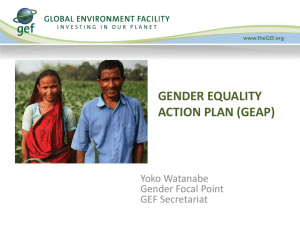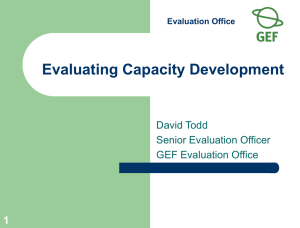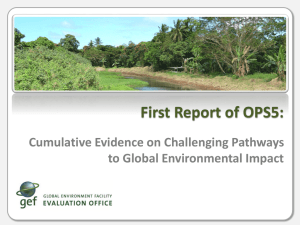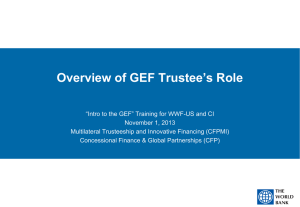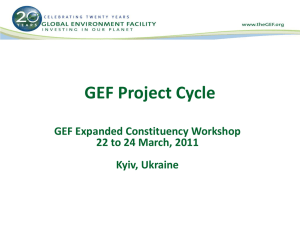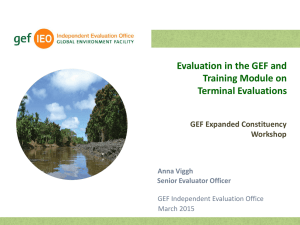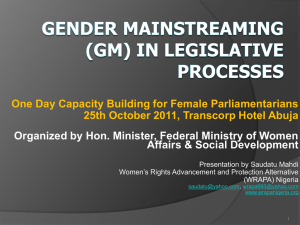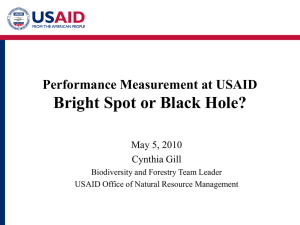Objective 1. Section I - Marc Foggin Photography
advertisement
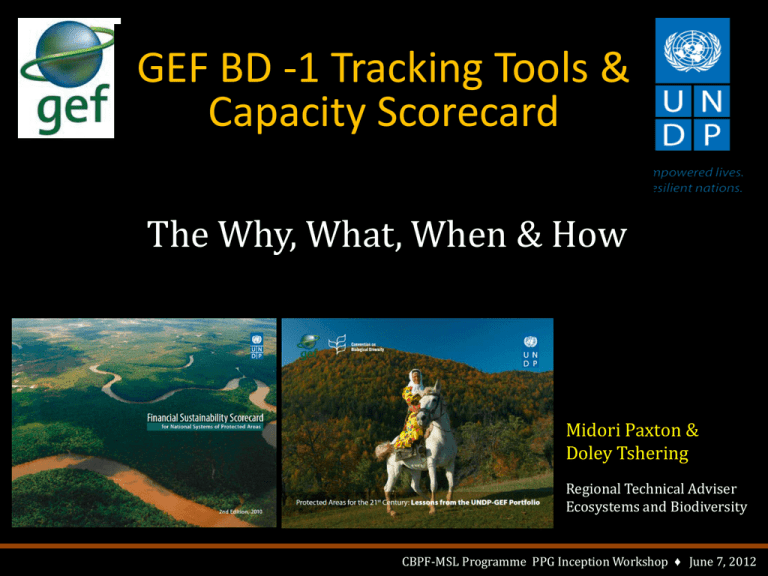
GEF BD -1 Tracking Tools & Capacity Scorecard The Why, What, When & How Midori Paxton & Doley Tshering Regional Technical Adviser Ecosystems and Biodiversity CBPF-MSL Programme PPG Inception Workshop ♦ June 7, 2012 Overview of this Presentation • Purpose of the GEF BD Tracking Tools (TTs) – Why? • Structure of the required GEF TTs – What? • Summary of GEF TT requirements – When? • Tips for completing the GEF BD TTs – How? Purpose of the GEF BD Tracking Tools To measure progress in achieving the impacts and outcomes established at the portfolio level under the biodiversity focal area • An important M&E tool • Demonstrates progress made against indicators common to all BD projects – can also reveal shortcomings • Helps to guide and inform project implementation Purpose of the GEF BD Tracking Tools Project data is aggregated for analysis of directional trends & patterns at a portfoliowide level to inform the development of future GEF strategies and to report to GEF Council on portfolio-level performance in the BD focal area • Allows for aggregation of results at the global level – each project counts – each project is counted • Aggregated results are then published by the GEF in the Annual Monitoring Report (AMR), shared with donors – provides justification for continued investment in BD programming Structure of the GEF BD Tracking Tools 5 Excel spreadsheets: – Objective 1. Section I – Objective 1. Section II – Objective 1. Section III – Objective 2. – Objective 3. Protected Areas Mainstreaming Biosafety Structure of the GEF TTs: Protected Areas 3 Excel spreadsheets for PA projects: – Objective 1. Section I – Objective 1. Section II – Objective 1. Section III Basic Info METT FSC Structure of the GEF TTs: Protected Areas Objective 1. Section I • Required of all projects that target PAs • Composed of 3 parts: I. General Data – must be completed by all projects that target PAs Structure of the GEF TTs: Protected Areas Objective 1. Section I • Required of all projects that target PAs • Composed of 3 parts: I. General Data – must be completed by projects that target PAs II. Total Extent in ha of PA targeted – provide all data on biomes, as available Structure of the GEF TTs: Protected Areas Objective 1. Section I • Required of all projects that target PAs • Composed of 3 parts: I. General Data – must be completed by projects that target PAs II. Total Extent in ha of PA targeted – provide all data on biomes, as available III. Table for PAs targeted – complete 1 table for each PA targeted; duplicate tables as necessary Structure of the GEF TTs: Protected Areas Objective 1. Section II (aka METT) • Management Effectiveness Tracking Tool • Composed of 2 parts, both should be completed: 1. Datasheets contains 2 separate sections: Datasheet 1: details of the assessment, basic info on PA Structure of the GEF TTs: Protected Areas Objective 1. Section II (aka METT) • Management Effectiveness Tracking Tool • Composed of 2 parts, both should be completed: 1. Datasheets contains 2 sections: Data Sheet 1: details of the assessment, basic info on PA Data Sheet 2: a generic list of threats that PAs face Structure of the GEF TTs: Protected Areas Objective 1. Section II (aka METT) • Management Effectiveness Tracking Tool • Composed of 2 parts, both should be completed: 1. Datasheets contains 2 separate sections: Datasheet 1: details of the assessment, basic info on PA Datasheet 2: a generic list of threats that PAs face. 2. Assessment Form contains 30 questions, all of which should be completed Structure of the GEF TTs: Protected Areas Objective 1. Section III (aka FSC) • Financial Sustainability Scorecard • Composed of 3 parts, all should be completed: Part I – Overall financial status of PA system Structure of the GEF TTs: Protected Areas Objective 1. Section III (aka FSC) • Financial Sustainability Scorecard • Composed of 3 parts, all should be completed: Part I – Overall financial status of PA system Part II – Assessing elements of the financing system Structure of the GEF TTs: Protected Areas Objective 1. Section III (aka FSC) • Financial Sustainability Scorecard • Composed of 3 parts, all should be completed: Part I – Overall financial status of PA system Part II – Assessing elements of the financing system Part III – Scoring Part II: UNDP Capacity Scorecard • UNDP’s definition and approach to CD • Key elements of the CD scorecard for BD projects • Example of a completed CD Scorecard UNDP Definition of CD Capacity Development: The process through which individuals, organizations and societies obtain, strengthen and maintain the capabilities to set and achieve their own development objectives over time Types of capacities – Functional capacities: which cut across all sectors: • • • • • « to engage stakeholders » « to assess a situation and define a vision » « to formulate policies and strategies » « to budget, manage and implement » « to monitor and evaluate » – Technical capacities: areas of expertise such as education, health, agriculture, etc. CD at 3 levels: a systems approach Enabling environment (policies, legislation, power relations, social norms Organisational level (policies, procedures, frameworks) Individual level (skills, knowledge, experience) UNDP CD Scorecard: Key elements • Aim: to assess the development of capacities vis-à-vis the management of protected areas • Strategic areas of support: 5 categories @ 3 levels (systemic, institutional and individual) 1. Capacity to conceptualize and formulate policies, legislations, strategies and programs 2. Capacity to implement policies, legislation, strategies and programs 3. Capacity to engage and build consensus among all stakeholders 4. Capacity to mobilize information and knowledge 5. Capacity to monitor, evaluate, report and learn • Indicators: used to specify what capacities need to be developed (see example later) • Scoring: how to – Worst (0); Marginal (1); Satisfactory (2); Best (3) – Baseline, target and total possible scores – Present as percentage of TPS Example of a completed detailed scorecard Strategic Area of Support Capacity Level Indicator 1. Capacity to conceptualize and formulate policies, legislations, strategies and programmes Systemic There is a strong and clear legal mandate for mainstreaming biodiversity into production sector activities in the EGREE 1. Capacity to conceptualize and formulate policies, legislations, strategies and programmes Institutional There is a multisectoral institutional mechanism responsible for mainstreaming biodiversity concerns into production sector activities in the EGREE that is able to prepare effective strategies and plans to this end There is no multisectoral institutional mechanism responsible for mainstreaming biodiversity concerns into production sector activities in the EGREE 2. Capacity to implement policies, legislation, strategies and programmes Systemic There are adequate skills for mainstreaming biodiversity into production sector activities in the EGREE There is a general lack of skills Worst (Score 0) There is no legal framework for biodiversity mainstreaming into production sector activities Marginal (Score 1) There is a partial legal framework for biodiversity mainstreaming into production sector activities, but it has many inadequacies 0 Scores Satisfactory (Score 2) There is a reasonable legal framework for biodiversity mainstreaming but it has a few weaknesses and gaps There is a multisectoral institutional mechanism responsible for mainstreaming biodiversity concerns into production sector activities in the EGREE but there is no clear strategy to this end Some skills exist but in largely insufficient quantities to guarantee effective biodiversity mainstreaming 1 2 Best (Score 3) There is a strong and clear legal mandate for biodiversity mainstreaming into production sector activities There is a multisectoral institutional mechanism responsible for mainstreaming biodiversity concerns into production sector activities in the EGREE, and there is an initial strategy to this end There is a multisectoral institutional mechanism responsible for mainstreaming biodiversity concerns into production sector activities in the EGREE, and there is a regularly updated strategy developed through wide stakeholder participation Necessary skills for effective biodiversity mainstreaming into production sector activities do exist but are stretched and not easily available Adequate quantities of the full range of skills necessary for effective biodiversity mainstreaming into production sector activities are easily available Example – total possible scores Strategic Areas of Support Total Possible Scores Systemic 1. Capacity to conceptualize and formulate policies, legislations, strategies and programme 3 Institution al 3 2. Capacity to implement policies, legislation, strategies and programmes 3. Capacity to engage and build consensus among all stakeholders 4. Capacity to mobilize information and knowledge: Technical skills related specifically to the requirements of GEF SO-2 and SP-4 5. Capacity to monitor, evaluate and report and learn at the sector and project levels 6 9 6 6 3 - 3 - 3 3 3 - 21 18 9 Total Note: "-" means no indicator was selected for that level. Individu al - Example – summary baseline scores Strategic Areas of Support Baseline Scores Systemic 1. Capacity to conceptualize and formulate policies, legislations, strategies and programme 2. Capacity to implement policies, legislation, strategies and programmes 3. Capacity to engage and build consensus among all stakeholders 4. Capacity to mobilize information and knowledge: Technical skills related specifically to the requirements of GEF SO-2 and SP-4 2 5. Capacity to monitor, evaluate and report and learn at the sector and project levels Total Note: "-" means no indicator was selected for that level. Instituti Individ onal ual 0 - 2 1 1 1 0 - 1 - 1 1 1 - 7 2 2 Example – summary target scores Strategic Areas of Support Target Scores Systemic Institutional Individual 1. Capacity to conceptualize and formulate policies, legislations, strategies and programme 2. Capacity to implement policies, legislation, strategies and programmes 3. Capacity to engage and build consensus among all stakeholders 4. Capacity to mobilize information and knowledge: Technical skills related specifically to the requirements of GEF SO-2 and SP-4 3 3 - 6 7 6 5 3 - 3 - 3 5. Capacity to monitor, evaluate and report and learn at the sector and project levels Total 3 3 - 20 16 9 Note: "-" means no indicator was selected for that level. Baseline scores as % of TPS Strategic Areas of Support Baseline Scores as % of TPS Systemic Institutional Individual 1. Capacity to conceptualize and formulate policies, legislations, strategies and programme 2. Capacity to implement policies, legislation, strategies and programmes 3. Capacity to engage and build consensus among all stakeholders 4. Capacity to mobilize information and knowledge: Technical skills related specifically to the requirements of GEF SO-2 and SP-4 67% 0% - 33% 11% 17% 17% 0% - 33% - 33% 5. Capacity to monitor, evaluate and report and learn at the sector and project levels Total 33% 33% - 33% 11% 22% Note: "-" means no indicator was selected for that level. Target scores as % of TPS Strategic Areas of Support Target Scores as % of TPS Systemic Institutional Individual 1. Capacity to conceptualize and formulate policies, legislations, strategies and programme 1. Capacity to implement policies, legislation, strategies and programmes 100% 100% - 100% 78% 100% 3. Capacity to engage and build consensus among all stakeholders 4. Capacity to mobilize information and knowledge: Technical skills related specifically to the requirements of GEF SO-2 and SP-4 5. Capacity to monitor, evaluate and report and learn at the sector and project levels Total 83% 100% - 100% - 100% 100% 100% - 95% 89% 100% Note: "-" means no indicator was selected for that level. In summary CD – a systems approach is necessary CD – it is about both functional and technical capacities CD scorecard – measures project CD interventions against a ideal (TPS) scenario, with measured baselines and appropriate target values As detailed as possible; use only relevant indicators Thank you

